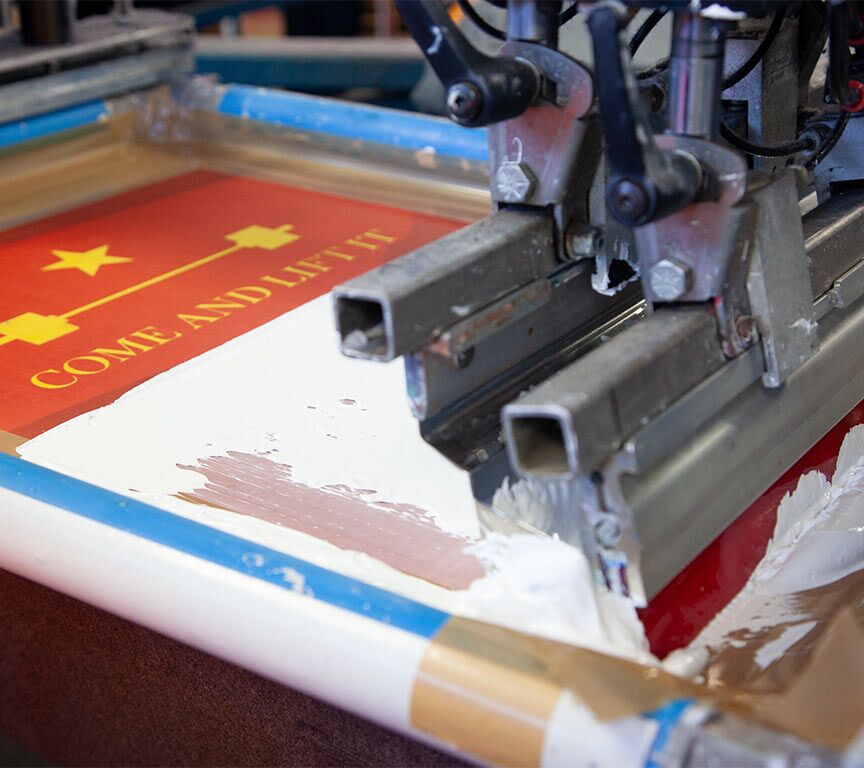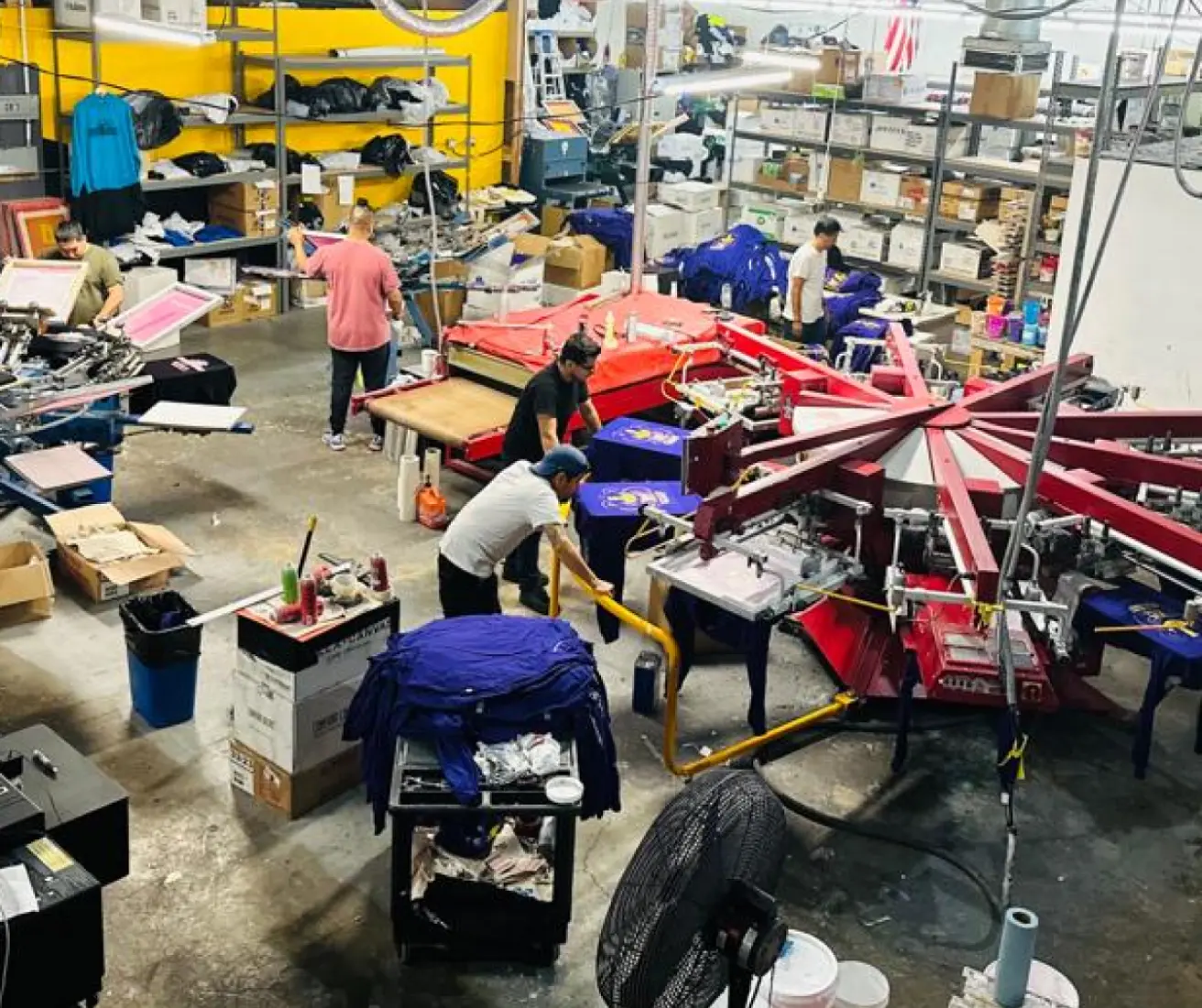Durable T-Shirt Printing for Everyday Wear
Durable T-Shirt Printing for Everyday Wear
Blog Article
Display Printing Uncovered: Every Little Thing You Need to Know About T-Shirt and Garment Printing Strategies
If you've ever wondered exactly how those lively styles end up on your favorite t-shirts, you remain in the best area. Display printing is a remarkable method that combines art with technique, supplying endless possibilities for creativity. Understanding the fundamentals, from tools to ink options, can greatly influence your results. Ready to check out the essential components that make screen publishing an art kind? Let's reveal the information that can raise your tasks.
The Basics of Screen Printing: How It Works
When you dive into display printing, you'll discover it's both a science and an art. At its core, display printing entails creating a stencil, or display, that permits ink to travel through just in particular locations (screen printing kit). You begin by choosing your design and preparing your screen with a light-sensitive solution. When you expose this solution to light, it solidifies, leaving your design as a negative space.
Position the display over the textile, after that make use of a squeegee to press ink through the display onto the garment. Each step is vital, and mastering them will certainly raise your screen printing abilities, transforming straightforward garments right into unique, meaningful items.
Sorts Of Display Printing Strategies
When you comprehend the basics of screen printing, it's time to discover the numerous techniques that can boost your styles. One preferred approach is typical display printing, where ink is pressed through a stenciled screen.
If you're intending for great details, think about discharge printing. This method gets rid of color from the textile, leaving a soft, vintage look. One more choice is plastisol printing, understood for its sturdiness and vibrant colors, making it a preferred for several brand names. Experiment with halftone printing to create gradient results and intricate designs. Each strategy has its special appeal, so do not wait to attempt them bent on locate what suits your style best!
Essential Devices for Display Printing
To achieve stunning results in screen printing, having the ideal tools is essential. You'll need a durable display printing frame, which holds the mesh that moves your layout onto the garment. Next off, spend in high-grade mops; these are essential for applying ink uniformly across the display.
Picking the Right Inks and Materials
When picking inks and materials for display printing, you require to consider the kind of ink that functions best for your task. Assume about textile compatibility to ensure your designs look excellent and last lengthy. Explore environmentally friendly ink options to make your printing procedure much more lasting.
Types of Display Inks
Picking the right display ink is essential for accomplishing vivid, durable prints that meet your project's needs. There are a number of types of display inks to examine. Plastisol ink is prominent for its flexibility and ease of usage, giving outstanding color opacity on dark textiles. Water-based ink, on the other hand, uses a softer feeling and is eco-friendly, making it ideal for those aiming to minimize their ecological influence. Release inks get rid of dye from the fabric, resulting in a soft, vintage look but call for specific handling. Finally, specialty inks, such as glow-in-the-dark or metallic, can include one-of-a-kind results to your layouts. Evaluate your job needs and select the ink that aligns best with your preferred result.

Textile Compatibility Considerations
Recognizing textile compatibility is essential for accomplishing top quality display prints, specifically considering that different materials respond uniquely to numerous inks. When selecting inks, consider the textile type-- cotton, polyester, or blends. For cotton, water-based inks work well, using softness and breathability. Polyester, on the various other hand, often calls for plastisol inks for far better attachment and dynamic shades. You may require to use a mix of both kinds if you're printing on blends. Always check your inks on sample material to guarantee they stick appropriately and keep color integrity. Furthermore, maintain in mind that fabric weight and texture can impact the final result, so picking the appropriate ink and material combination is essential for your task's success.
Eco-Friendly Ink Options
Environment-friendly inks are becoming a prominent choice for display printers who want to minimize their environmental effect while keeping high quality. When choosing inks, think about water-based inks, which are less damaging and much easier to cleanse up compared to conventional solvents.
In addition, seek inks made from eco-friendly resources, such as soy or vegetable-based choices. By choosing the appropriate inks and materials, you'll not just develop sensational layouts but also add to a much more sustainable printing procedure. Make the switch, and your prints will mirror your dedication to the setting!
Preparing Your Style for Display Printing

Submit Style Needs
To ensure your design looks lively and sharp on textile, you'll need to pay close interest to submit layout requirements for screen printing. Make certain your layout has a transparent history to protect against undesirable white sides on your prints. Maintain shade settings in mind; CMYK is typical for screen printing, so convert your RGB develops accordingly.
Color Separation Techniques
Color splitting up is an important action in preparing your style for screen printing, and understanding it can greatly enhance your print high quality. You'll require to break your style right into private shades, as each shade requires a different display during printing. Beginning by identifying all the shades in your layout and develop layers each. You can make use of software application like Adobe Photoshop or Illustrator to isolate and separate shades effectively. Be certain to conserve each layer as a different file, usually in a style like TIFF or PSD. This precision not just assures exact shade representation but likewise simplifies the printing process. By paying focus to shade splitting up, you'll attain professional and dynamic cause your screen-printed garments.
Resolution and Size
Attaining the most effective cause display printing starts with assuring your layout has the right resolution and size. Ideally, your artwork ought to go to least 300 DPI (dots per inch) for sharp, clear prints. Your last product could look less than professional and pixelated. if you use lower visit here resolution.
When it involves size, think about the measurements of your print location. Style your artwork to match the final print size, preferably producing it in the actual measurements you'll be publishing. In this manner, you'll avoid any unforeseen scaling issues.
Always check your layout in both vector and raster formats. Vector graphics can be scaled without shedding high quality, making them excellent for screen printing. Preparing properly will ensure your style looks outstanding on every garment!
Step-by-Step Screen Printing Refine
Screen printing is a vibrant process that permits you to develop lively layouts on various surface areas. To get begun, you'll require a screen, emulsion, and your picked ink.
Pour ink onto the screen and utilize a squeegee to press the ink through the pattern onto the material. Lift the screen very carefully and let the print completely dry. You've successfully display printed your design.
Tips for Effective Display Printing Projects
While you're diving into your display printing jobs, bear in mind that preparation is key to success. Start by gathering all your products-- inks, displays, squeegees, and garments. A tidy work space helps stop undesirable errors, so tidy up prior to you start.
Next, confirm your artwork is high-resolution and appropriately sized for your garment. Check your screen for correct direct exposure and tidy it extensively to avoid spots. When blending your inks, adhere to the producer's guidelines to achieve the best consistency.
During printing, apply also stress with your squeegee for regular results. Do not rush; take your time to validate each print fulfills your criteria. After printing, allow your garments completely dry completely before managing or packaging them.
Finally, constantly maintain an example of your help future recommendation. In this manner, you can analyze your progression and enhance your strategies gradually. Pleased printing!

Regularly Asked Concerns
How Long Does It Require To Set up a Display Printing Job?
Establishing a display printing work generally takes around 30 minutes to an hour. You'll prepare the screens, mix inks, and readjust journalism. The moment differs based upon intricacy and experience, so remain arranged!
Can I Publish on Various Fabric Keys In Utilizing the Same Strategy?
Yes, you can publish on different fabric kinds making use of the same technique, yet you'll require to change your settings and inks. Some materials soak up ink in different ways, so exploring assurances the very best results for each and every material.
What Prevail Blunders to Avoid in Display Printing?
When display printing, prevent typical blunders like making use of the wrong ink, ignoring appropriate direct exposure times, or missing pre-press checks. this post Constantly check your configuration and keep tidy displays to assure high quality outcomes each time.
How Can I Appropriately Clean and Maintain My Screen Printing Devices?
To appropriately tidy and preserve your screen printing devices, you ought to regularly clean displays with appropriate solvents, inspect squeegees for wear, and assure all tools are stored dust-free and completely dry. Consistency prevents costly repair work and enhances performance.
Is Display Printing Ecologically Pleasant Compared to Other Approaches?
Screen printing can be extra eco-friendly than other techniques, particularly if you make use of water-based inks and eco-conscious products. By picking lasting products and methods, you decrease waste and minimize your effect on the planet.
Screen Printing Uncovered: Whatever You Required to Know Concerning Tee and Garment Printing Techniques
At its core, display printing entails developing a pattern, or display, that allows ink to pass with just in details locations. Placement the screen over the textile, after that utilize a squeegee to press ink through the screen onto the garment. One preferred method is standard screen printing, where ink is pushed via a stenciled display.When picking inks and products for screen printing, you need to take right into account the kind of ink that works ideal for your task.
Report this page